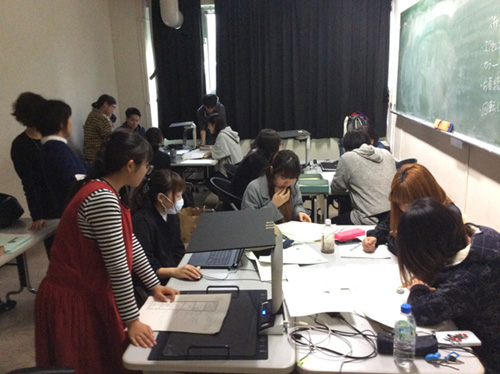[Interview] A closer look at the work of an archivist – SUZUKI Jun

The activities of the Archive Center for Anime Studies comprise a collection of effort by many different people, and among them, archivists play an indispensable role. We interviewed SUZUKI Jun, who has been supporting this project as an archivist since 2017 and is part of the Niigata University Graduate School of Modern Society and Culture. We spoke to her about how she came to participate in this project and the kind of activities she has been involved in.
The path to participation in the Anime Archive Research Project
――I always thought you were a researcher of live-action films, so I was surprised to see that you archive animation. Please tell us how that came to pass.
Suzuki It started in the second year of my doctoral program, in 2017. I originally enrolled in the master’s program at Niigata University’s Graduate School because I wanted to research J-horror, and I decided to research Japanese films during Japan’s occupation for my doctoral studies. In the course of my research, I had many opportunities to come into contact with scripts, which are intermediate materials for live-action films, as well as documents and memos relating to censorship, so I was asked by Prof. Ishida if I would like to archive the intermediate animation materials. I think that was how it happened.
Changes in archiving activities. Wings of Honnêamise as a turning point.
――I understand you no longer use the scanner you bought when you initially started (at the start of the “Hyougen Project Seminar U”[1]).
Suzuki What the students used in the HyouPro was an overhead scanner (Fig. 1). With that scanner, the uncovered materials were pressed from above with a plastic board to temporarily smooth out wrinkles and folds, but the board often reflected the fluorescent light and made it quite difficult to scan cleanly. It does have the advantage of being able to quickly check that the materials are straight in terms of alignment and that no dust or the like has got trapped, though. Nowadays I mainly use a close-up scanner (Fig. 2). With this scanner, you place the materials on the document table and close the lid to scan, so you don’t get the problem of reflections from fluorescent light. However, it took me a little while to get used to it, because sometimes materials I thought I had placed straight were actually at a slight angle, or shifted when I closed the lid. Nevertheless, you can set the resolution and color of the images in detail each time, so you can experiment with various settings appropriate for the nature of each archive. When I was working on Royal Space Force: The Wings of Honnêamise, I still didn’t know the features of each scanner that well (I still don’t), so I just used both types of scanners – overhead and close-up – depending on the size of the material.


――Has the specific process of archiving work changed since you started using close-up scanners?
Suzuki As I mentioned earlier, this scanner has a lot to offer, from settings to everything else, and allows you to make changes depending on how the image will be used. So, I think to myself, “What would happen with this setting?” and try a number of options in advance, and then ask for opinions from Prof. Ishida and Prof. Kim before deciding on the settings for the scan. Also, when scanning, I make a margin around the material so that I can capture every inch of it. The scanning area settings are set manually, so this fine tuning took some time to get used to. However, I was able to check in great detail to see if any of the material had been left out or was folded.
――Doing something manually allows you to be meticulous, doesn’t it.
Suzuki That’s right. It was only after using a close-up scanner that I started paying attention to the resolution, color, and brightness of the images. Even changing just one setting dramatically changes the resulting image data, so I’m still learning through trial and error.
More to archiving activities than capturing images
Suzuki Also, and I think this relates to printing technology, even if the resolution is good enough for viewing the data on a computer, when you print to paper or some other material, it can sometimes make you wonder what went wrong. For example, the data for Royal Space Force: The Wings of Honnêamise was used in exhibitions at the Hachioji Yume Art Museum, and in Singapore and Sweden, but to be honest, I was deeply concerned until I saw it in print, because I didn’t expect my work to be used in such a way.
――So it’s not just a matter of capturing an image, you need to think about archiving taking into account future use as well.
Suzuki I think that’s exactly right. I think we have to do our work by imagining how this data could be used in the future, and then thinking about what we should and can do now in order to make that happen. After all, it’s no good if, 50 or 100 years from now, all people think is, “Apparently there was some nerd at Niigata University who was really obsessed with detail” (laughs).
Footnotes
- The Hyougen Project Seminar is one of the compulsory courses at the Faculty of Humanities at Niigata University. The content is more practical and widely open to local communities and cultures. The Animation Archive has been up and running since the 2016 Hyougen Project Seminar, which is abbreviated to “HyouPro.”
Profile
Interview date: August 18, 2020
Interview/text: TAKEUCHI Tomoha (Master’s Program, Graduate School of Modern Society and Culture)
Related Links:
Research of Archiving Anime

 SUZUKI Jun
SUZUKI Jun